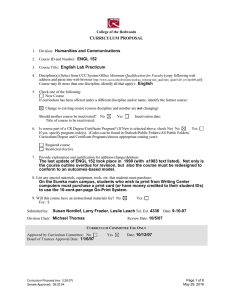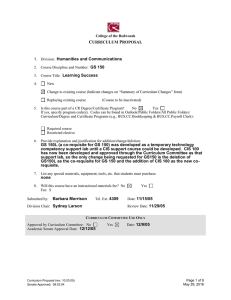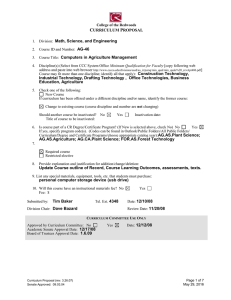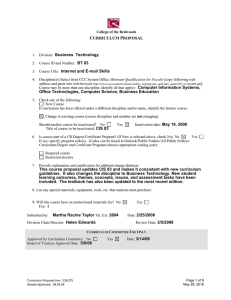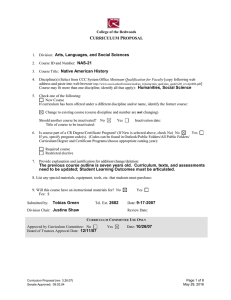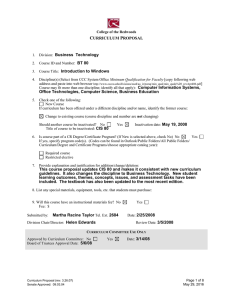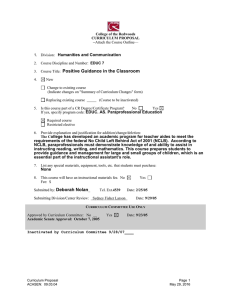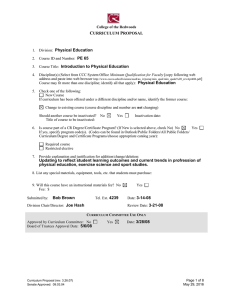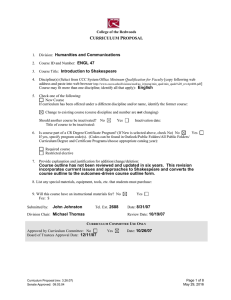C P URRICULUM
advertisement
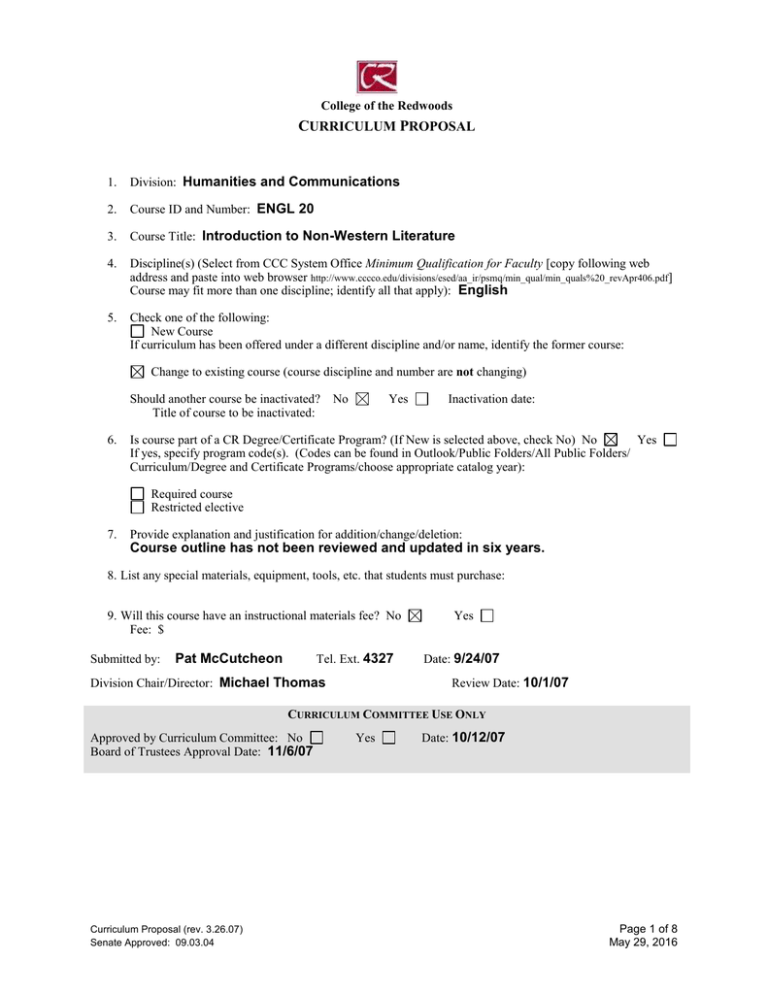
College of the Redwoods CURRICULUM PROPOSAL 1. Division: Humanities and Communications 2. Course ID and Number: ENGL 20 3. Course Title: Introduction to Non-Western Literature 4. Discipline(s) (Select from CCC System Office Minimum Qualification for Faculty [copy following web address and paste into web browser http://www.cccco.edu/divisions/esed/aa_ir/psmq/min_qual/min_quals%20_revApr406.pdf] Course may fit more than one discipline; identify all that apply): English 5. Check one of the following: New Course If curriculum has been offered under a different discipline and/or name, identify the former course: Change to existing course (course discipline and number are not changing) Should another course be inactivated? Title of course to be inactivated: 6. No Yes Inactivation date: Is course part of a CR Degree/Certificate Program? (If New is selected above, check No) No Yes If yes, specify program code(s). (Codes can be found in Outlook/Public Folders/All Public Folders/ Curriculum/Degree and Certificate Programs/choose appropriate catalog year): Required course Restricted elective 7. Provide explanation and justification for addition/change/deletion: Course outline has not been reviewed and updated in six years. 8. List any special materials, equipment, tools, etc. that students must purchase: 9. Will this course have an instructional materials fee? No Fee: $ Submitted by: Pat McCutcheon Tel. Ext. 4327 Division Chair/Director: Michael Thomas Yes Date: 9/24/07 Review Date: 10/1/07 CURRICULUM COMMITTEE USE ONLY Approved by Curriculum Committee: No Board of Trustees Approval Date: 11/6/07 Curriculum Proposal (rev. 3.26.07) Senate Approved: 09.03.04 Yes Date: 10/12/07 Page 1 of 8 May 29, 2016 SUMMARY OF CURRICULUM CHANGES FOR AN EXISTING COURSE FEATURES Catalog Description (Please include complete text of old and new catalog descriptions.) Grading Standard OLD NEW An introduction to the literatures of Asia, Africa, and Latin America through the study of major works in their literary and cultural contexts. Selected readings are from both ancient and modern authors and include poetry as well as representative myths, epics, stories, and narratives. An introduction to the major works of Asia, Africa, and Latin America in their literary and cultural contexts. Readings include authors from ancient to modern and representative myths, epics, stories, and poems. Select Select Total Units Lecture Units Lab Units Prerequisites Corequisites Recommended Preparation Maximum Class Size Repeatability— Maximum Enrollments Other Student learning outcomes, course content, course learning activities, and new text have been added. If any of the listed features have been modified in the new proposal, indicate the “old” (current) information and proposed changes. Curriculum Proposal (rev. 3.26.07) Senate Approved: 09.03.04 Page 2 of 8 May 29, 2016 College of the Redwoods COURSE OUTLINE DATE: 9/24/07 COURSE ID AND NUMBER: ENGL 20 COURSE TITLE: Introduction to Non-Western Literature FIRST TERM NEW OR REVISED COURSE MAY BE OFFERED: Spring 2008 TOTAL UNITS: 3 TOTAL HOURS: 54 [Lecture Units: 3 [Lecture Hours: 54 Lab Units: Lab Hours: ] ] MAXIMUM CLASS SIZE: 38 GRADING STANDARD Letter Grade Only CR/NC Only Is this course repeatable for additional credit units: No Grade-CR/NC Option Yes If yes, how many total enrollments? Is this course to be offered as part of the Honors Program? No Yes If yes, explain how honors sections of the course are different from standard sections. Honors sections will have additional reading and writing assignments: typically a paper examining an author or work in greater depth and a classroom presentation of the findings. In addition, Honors essays will reflect the reading of secondary sources-historical, cultural, and/or critical works--which may not be a requirement in regular sections. Honors students will also take a more active role in conducting the class by leading discussions. CATALOG DESCRIPTION The catalog description should clearly state the scope of the course, its level, and what kinds of student goals the course is designed to fulfill. An introduction to the major works of Asia, Africa, and Latin America in their literary and cultural contexts. Readings include authors from ancient to modern and representative myths, epics, stories, and poems. Special notes or advisories: PREREQUISITES No Yes Course(s): Rationale for Prerequisite: Describe representative skills without which the student would be highly unlikely to succeed. COREQUISITES No Yes Rationale for Corequisite: Curriculum Proposal (rev. 3.26.07) Senate Approved: 09.03.04 Course(s): Page 3 of 8 May 29, 2016 RECOMMENDED PREPARATION No Yes Course(s): ENGL 1A Rationale for Recommended Preparation: To be successful in ENGL 20, students must have college-level reading and writing skills, including some familiarity with academic research conventions and MLA citation style. COURSE LEARNING OUTCOMES What should the student be able to do as a result of taking this course? State some of the objectives in terms of specific, measurable student accomplishments. 1. Discuss works of non-Western literature within their historical, aesthetic, and cultural contexts. 2. Articulate interpretations of themes, character, plot development and stylistic features in works of literature to build cogent and logical critical arguments. 3. Persist in the reading and study of a text that may seem alien because of historical and cultural shifts and that may appear in uncommon genres (e.g. creation myths, epics, sermons, surrealism). 4. Reflect on the act of reading as a relationship between reader and text: both on the cultural, aesthetic, and personal bases for literary response and on the power of literature to transform our values and world views. 5. Explain how literary works of different periods and different areas reflect varying cultural influences. 6. Articulate significant themes recurring in works throughout the non-Western world. 7. Discuss the use of literature as one way to investigate the changing historical and cultural aspects of our world. COURSE CONTENT Themes: What themes, if any, are threaded throughout the learning experiences in this course? 1. Historical and cultural change reflected in the works of Asia, Aftica, and Latin America. 2. The relationship between individual author and social conventions. 3. The means by which a culture's literature bears witness to its social, political, religious, intellectual, and psychological ideas. 4. Reasoned critical argument. Concepts: What concepts do students need to understand to demonstrate course outcomes? 1. Cultural difference. 2. Literary genres, audience, rhetorical and stylistic features, and other basic concepts central to literary criticism. 4. Differing concepts of identity. 5. Race/ethnicity. 6. The ancient world. 7. Colonialism. 8. Modernism. 9. Postmodernism. 10. Postcolonialism. 11. Magical Realism. 12. Globalism. Curriculum Proposal (rev. 3.26.07) Senate Approved: 09.03.04 Page 4 of 8 May 29, 2016 Issues: What primary issues or problems, if any, must students understand to achieve course outcomes (including such issues as gender, diversity, multi-culturalism, and class)? 1. Challenges to traditional authority-- religious, intellectual, political, colonial, social, familial, and sexual. 2. Bridging the gap between 21st-century readers and works written up to thousands of years ago. 3. Suspending cultural bias. 4. Understanding the limits of literary translation. 5. The process of critical reading as relationship beetween the reader and the text. Skills: What skills must students master to demonstrate course outcomes? 1. Reading challenging texts carefully and thoughtfully. 2. Analyzing details of literary works to form interpretations. 3. Writing to discover, to articulate, and to clarify an interpretation. 4. Applying basic vocabulary used to discuss literary works. 5. Writing critical essays that conform to standard MLA format/citation style. REPRESENTATIVE LEARNING ACTIVITIES What will students be doing (e.g., listening to lectures, participating in discussions and/or group activities, attending a field trip)? Relate the activities directly to the Course Learning Outcomes. 1. 2. 3. 4. Listening to lectures. Participating in discussions. Participating in group activities. Interacting with guest speakers from non-Western cultures. ASSESSMENT TASKS How will students show evidence of achieving the Course Learning Outcomes? Indicate which assessments (if any) are required for all sections. Representative assessment tasks: 1. Reading quizzes, reading journals, reading questions. 2. Student presentations. 3. Essay exams. Required assessments for all sections – to include but not limited to: At least two critical essays conforming to standard MLA format/citation style. EXAMPLES OF APPROPRIATE TEXTS OR OTHER READINGS Author, Title, and Date Fields are required Author Davis, et al. Title The Bedford Anthology of World Literature, Volume 1: The Ancient World - 100 C.E. Date 2005 or latest edition Author Davis, Date et al Title The Bedford Anthology of World Literature, Volume 6 : 1900-Present 2004 or latest edition Author Barnstone and Barnstone or latest edition Author Title Title Literatures of Asia, Africa and Latin America Date 1999 Date Other Appropriate Readings: Chenua Achebe's "Things Fall Apart," or similar novels Curriculum Proposal (rev. 3.26.07) Senate Approved: 09.03.04 Page 5 of 8 May 29, 2016 PROPOSED TRANSFERABILITY: CSU UC If CSU transferability is proposed (courses numbered 1-99), indicate whether general elective credit or specific course equivalent credit is proposed. If specific course equivalent credit is proposed, give course numbers/ titles of at least two comparable lower division courses from a UC, CSU, or equivalent institution. None General elective credit Specific course equivalent 1. CL9, UC Irvine (Campus) 2. Engl 190, CSU Santa Barbara (Campus) CURRENTLY APPROVED GENERAL EDUCATION CR CSU IGETC CR GE Category: C Humanities CSU GE Category: C2 Humanities IGETC Category: Area 3 Group B Humanities PROPOSED CR GENERAL EDUCATION Rationale for CR General Education approval (including category designation): Natural Science Social Science Humanities Language and Rationality Writing Oral Communications Analytical Thinking PROPOSED CSU GENERAL EDUCATION BREADTH (CSU GE) A. Communications and Critical Thinking A1 – Oral Communication A2 – Written Communication A3 – Critical Thinking C. Arts, Literature, Philosophy, and Foreign Language C1 – Arts (Art, Dance, Music, Theater) C2 – Humanities (Literature, Philosophy, Foreign Language) E. Lifelong Understanding and SelfDevelopment E1 – Lifelong Understanding E2 – Self-Development B. Science and Math B1 – Physical Science B2 – Life Science B3 – Laboratory Activity B4 – Mathematics/Quantitative Reasoning D. Social, Political, and Economic Institutions D0 – Sociology and Criminology D1 – Anthropology and Archeology D2 – Economics D3 – Ethnic Studies D5 – Geography D6 – History D7 – Interdisciplinary Social or Behavioral Science D8 – Political Science, Government and Legal Institutions D9 – Psychology Rationale for inclusion in this General Education category: Same as above Curriculum Proposal (rev. 3.26.07) Senate Approved: 09.03.04 Page 6 of 8 May 29, 2016 Proposed Intersegmental General Education Transfer Curriculum (IGETC) 1A – English Composition 1B – Critical Thinking-English Composition 1C – Oral Communication (CSU requirement only) 2A – Math 3A – Arts 3B – Humanities 4A – Anthropology and Archaeology 4B – Economics 4E – Geography 4F – History 4G – Interdisciplinary, Social & Behavioral Sciences 4H – Political Science, Government & Legal Institutions 4I – Psychology 4J – Sociology & Criminology 5A – Physical Science 5B – Biological Science 6A – Languages Other Than English Rationale for inclusion in this General Education category: Curriculum Proposal (rev. 3.26.07) Senate Approved: 09.03.04 Same as above Page 7 of 8 May 29, 2016 FOR VPAA USE ONLY PROGRAM AND COURSE NUMBER ENGL-20 TECHNICAL INFORMATION 1. Department: HUM Humanities 16. CoRequisite Course: None 2. Subject: English 17. Recommended Prep: ENGL-1A Course No: 20 3. Credit Type: D Credit Degree Applicable 18. Maximum Class Size: 38 4. Min/Maximum Units: 3.0 to 19. Repeat/Retake: NR No repeats variable units 5. Course Level: Choose One: 20. Count Retakes for Credit: yes no 6. Academic Level: UG Undergraduate 21. Only Pass/No Pass: yes no 7. Grade Scheme: UG Undergraduate 22. Allow Pass/No Pass: yes no 8. Short Title: Intro to Non-Western Lit 23. VATEA Funded Course: yes no 9. Long Title: Introduction to Non-Western 24. Accounting Method: W Weekly Census Literature 25. Disability Status: N Not a Special Class 10. National ID (CIP): 16.0104 26. Billing Method: T-Term 11. Local ID (TOPS): 150300 27. Billing Period: R-Reporting Term 12. Course Types: Level One Basic Skills: NBS Not Basic Skills Level Two Work Experience: 28. Billing Credits: 3.0 29. Purpose: A Liberal Arts Sciences NWE Not Coop Work Experience 30. Articulation No. Level Three: (CAN): Placeholder for GE OR 31. Articulation Seq. (CAN): Choose One: 32. Transfer Status: A Transfers to both UC/CSU Level Four: If GE : C2 Humanities (Lit, Phil, Lan) 13. Instructional Method: LEC Lecture and/or Discussion 33. Equates to another course? (course number). 34. The addition of this course will inactive number). Inactive at end of term. 14. Lec TLUs: 4.5 Contact Hours: 54 Lab TLUs: Contact Hours: Lecture/Lab TLUs: Contact Hours: 15. Prerequisite: None Particular Comments for Printed Catalog. . Curriculum Approval Date: 10/12/07 Curriculum Proposal (rev. 3.26.07) Senate Approved: 09.03.04 Page 8 of 8 May 29, 2016 (course
